


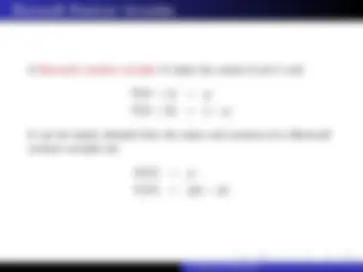




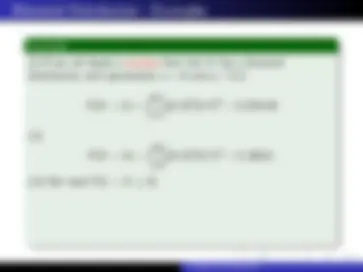
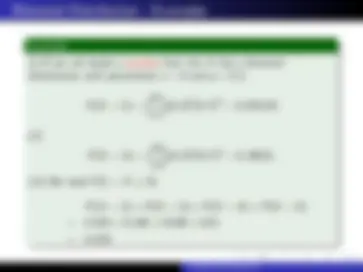


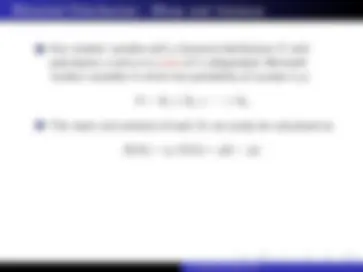
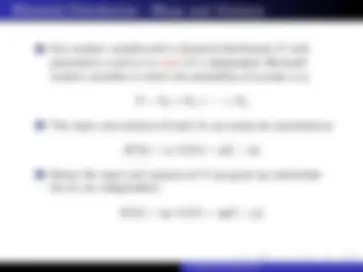



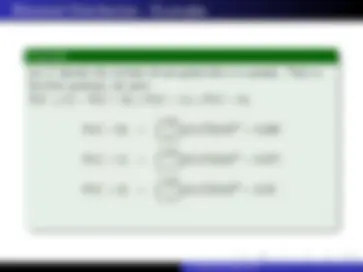
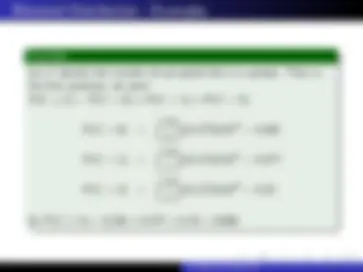


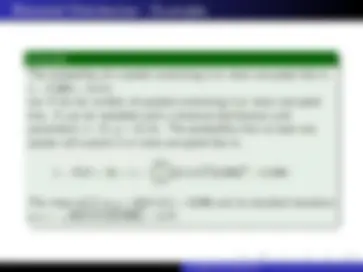


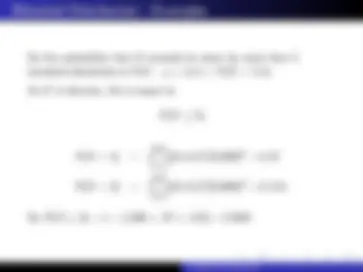


Study with the several resources on Docsity

Earn points by helping other students or get them with a premium plan


Prepare for your exams
Study with the several resources on Docsity

Earn points to download
Earn points by helping other students or get them with a premium plan
Community
Ask the community for help and clear up your study doubts
Discover the best universities in your country according to Docsity users
Free resources
Download our free guides on studying techniques, anxiety management strategies, and thesis advice from Docsity tutors
This lecture is from Business Statistics. Key important points are: Binomial Distribution, Bernoulli Trial, Production Line, Bernoulli Random Variables, Binomial Experiments, Mean and Variance, Probability of Success, Random Variable, Probability
Typology: Slides
1 / 32

This page cannot be seen from the preview
Don't miss anything!

























October 20, 2010
Definition A Bernoulli trial is a random experiment in which there are only two possible outcomes - success and failure.
(^1) Tossing a coin and considering heads as success and tails as failure.
Definition A Bernoulli trial is a random experiment in which there are only two possible outcomes - success and failure.
(^1) Tossing a coin and considering heads as success and tails as failure. (^2) Checking items from a production line: success = not defective, failure = defective. (^3) Phoning a call centre: success = operator free; failure = no operator free.
A Bernoulli random variable X takes the values 0 and 1 and
P(X = 1) = p P(X = 0) = 1 − p.
It can be easily checked that the mean and variance of a Bernoulli random variable are
E (X ) = p V (X ) = p(1 − p).
Consider the following type of random experiment: (^1) The experiment consists of n repeated Bernoulli trials - each trial has only two possible outcomes labelled as success and failure; (^2) The trials are independent - the outcome of any trial has no effect on the probability of the others;
Consider the following type of random experiment: (^1) The experiment consists of n repeated Bernoulli trials - each trial has only two possible outcomes labelled as success and failure; (^2) The trials are independent - the outcome of any trial has no effect on the probability of the others; (^3) The probability of success in each trial is constant which we denote by p.
Definition The random variable X that counts the number of successes, k, in the n trials is said to have a binomial distribution with parameters n and p, written bin(k; n, p).
The probability mass function of a binomial random variable X with parameters n and p is
f (k) = P(X = k) =
n k
pk^ (1 − p)n−k
for k = 0, 1 , 2 , 3 ,... , n.
Definition The random variable X that counts the number of successes, k, in the n trials is said to have a binomial distribution with parameters n and p, written bin(k; n, p).
The probability mass function of a binomial random variable X with parameters n and p is
f (k) = P(X = k) =
n k
pk^ (1 − p)n−k
for k = 0, 1 , 2 , 3 ,... , n. (n k
counts the number of outcomes that include exactly k successes and n − k failures.
Example (i) If we call heads a success then this X has a binomial distribution with parameters n = 6 and p = 0.3.
Example (i) If we call heads a success then this X has a binomial distribution with parameters n = 6 and p = 0.3.
(ii)
P(X = 3) =
(iii) We need P(1 < X ≤ 5)
Example A quality control engineer is in charge of testing whether or not 90% of the DVD players produced by his company conform to specifications. To do this, the engineer randomly selects a batch of 12 DVD players from each day’s production. The day’s production is acceptable provided no more than 1 DVD player fails to meet specifications. Otherwise, the entire day’s production has to be tested. (i) What is the probability that the engineer incorrectly passes a day’s production as acceptable if only 80% of the day’s DVD players actually conform to specification? (ii) What is the probability that the engineer unnecessarily requires the entire day’s production to be tested if in fact 90% of the DVD players conform to specifications?
Example (i) Let X denote the number of DVD players in the sample that fail to meet specifications. In part (i) we want P(X ≤ 1) with binomial parameters n = 12, p = 0.2.
P(X ≤ 1) = P(X = 0) + P(X = 1)
=
(^1) Any random variable with a binomial distribution X with parameters n and p is a sum of n independent Bernoulli random variables in which the probability of success is p.
X = X 1 + X 2 + · · · + Xn.
(^1) Any random variable with a binomial distribution X with parameters n and p is a sum of n independent Bernoulli random variables in which the probability of success is p.
X = X 1 + X 2 + · · · + Xn.
(^2) The mean and variance of each Xi can easily be calculated as:
E (Xi ) = p, V (Xi ) = p(1 − p).